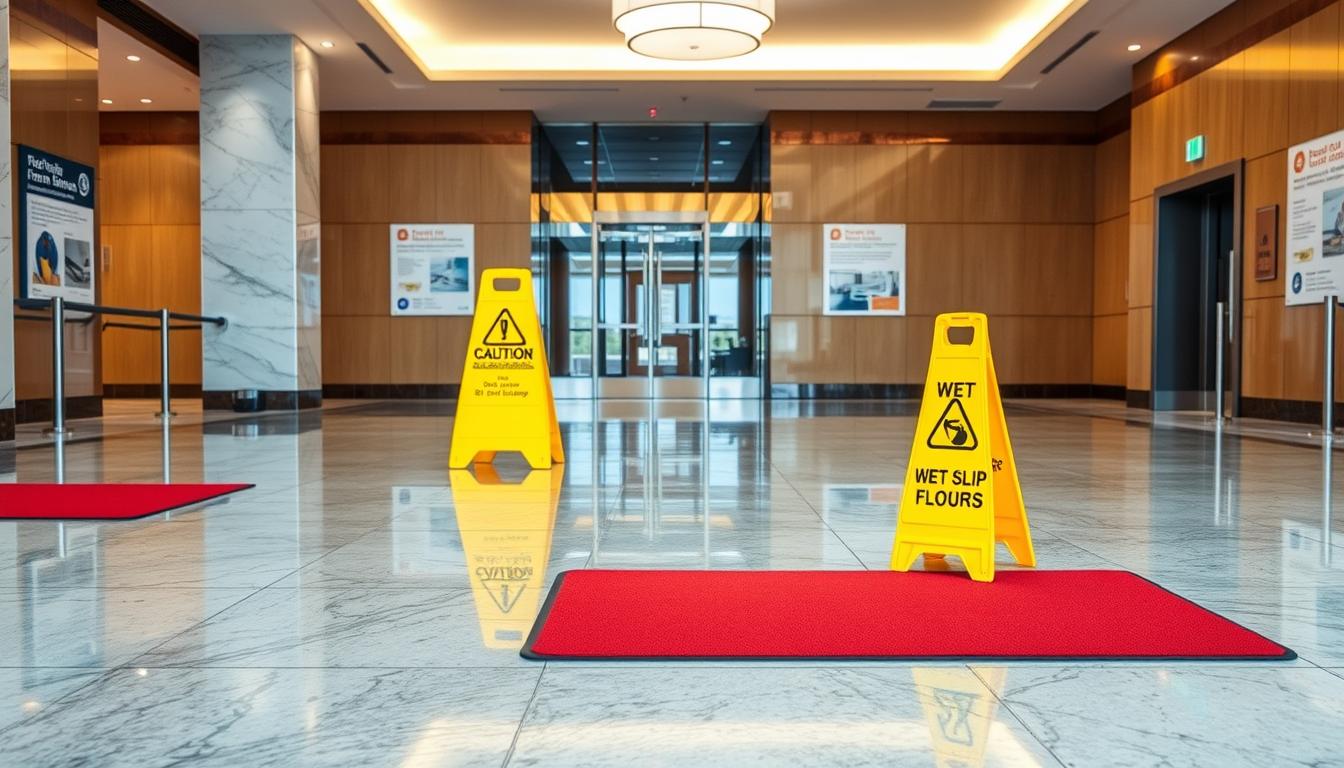Did you know that nearly 40% of all workplace injuries in the United States are caused by slips, trips, and falls? This is a shocking fact that shows how important it is to prevent slippery floors in commercial buildings. Businesses in Atlanta and elsewhere are working hard to make their places safe for everyone. This guide will show you how to prevent slippery floors and follow safety rules.
It’s very important to know how to keep floors safe in commercial areas. This guide will give you important information on the right materials and how to take care of them. By following these tips, businesses can make their places safer for everyone.
Key Takeaways
- Slips, trips, and falls account for 40% of workplace injuries in the U.S.
- Prioritizing floor safety can protect employees and customers alike.
- Implementing preventive measures is essential for compliance with safety regulations.
- Understanding materials and maintenance techniques is key to commercial floor safety.
- Continual education on slippery floor prevention strengthens safety protocols.
Understanding the Importance of Floor Safety in Commercial Settings
Floor safety is key for the health and safety of everyone in commercial places. It helps prevent accidents and lowers the risk of legal trouble. Not taking safety seriously can lead to big problems under OSHA rules.
It’s vital to have a detailed floor safety checklist. This checklist should cover things like floor materials, how to clean, and when to do maintenance. Teaching employees about these points helps create a safe work culture.
Having solid floor safety plans can really cut down on slip and fall risks. Training and awareness programs are important. They make sure everyone knows their role in keeping things safe. Regular checks also help spot and fix hazards before they become big problems.
Common Causes of Slippery Floors in Facilities
It’s key to know why floors get slippery in commercial places. Many things can make floors dangerous, leading to serious accidents. By spotting these issues, managers can take steps to make floors safer.
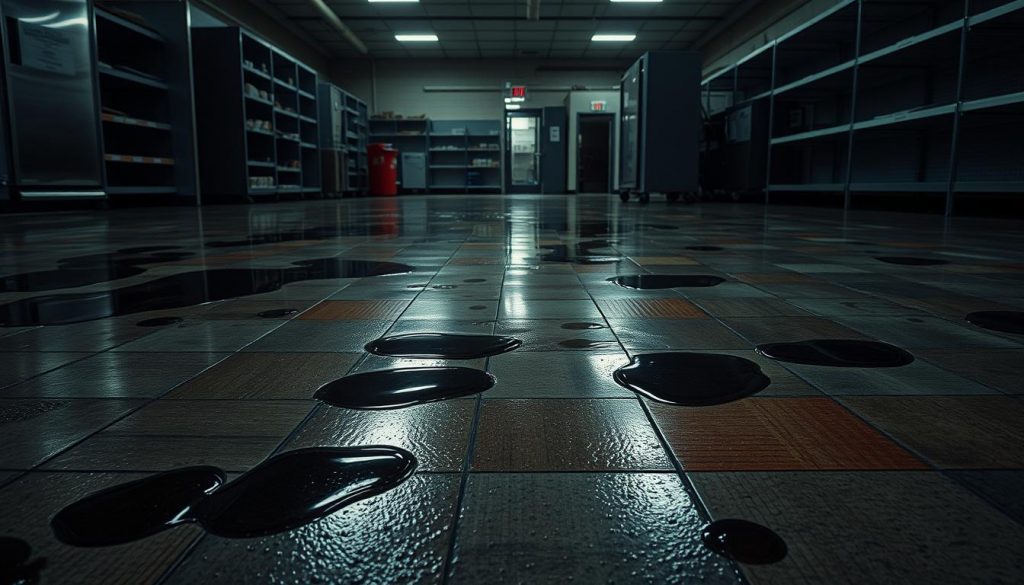
Spills are a big problem. Water, oil, and cleaning liquids can make floors very slippery if not cleaned up fast. Also, too much moisture in busy spots can cause slips and falls.
Some floors are naturally slippery. Tile or polished concrete might look nice but don’t grip well, making them risky when wet. Choosing floors that are easier to walk on is important for safety.
Weather changes can make floors slippery too. Rain or snow can bring water inside, raising the risk of slipping. Managers need to keep floors safe all year by adjusting their plans.
It’s important to check floors often and keep them in good shape. Regular checks help find and fix problems before they cause accidents. This way, everyone can stay safe in a facility.
Effective Strategies for Slippery Floor Prevention in Commercial Buildings
Effective strategies can greatly lower the risk of accidents in commercial buildings. A key part is improving drainage systems to remove excess water. This water often makes floors slippery and dangerous.
Using non-slip mats at entrances and exits is also important. These mats catch moisture and dirt, keeping floors clean. It’s vital to clean floors regularly, using the right methods for each type of floor.
For example, vinyl and tile floors need a mild detergent for mopping. Carpets should be vacuumed and deep cleaned often.
Cleaning spills right away is another key step. It’s important to have quick cleanup policies and to warn people about hazards. Good lighting is also essential to keep areas safe and well-lit.
Studies show that these strategies work well in different commercial places. For more tips on keeping your workplace safe, check out effective strategies online.
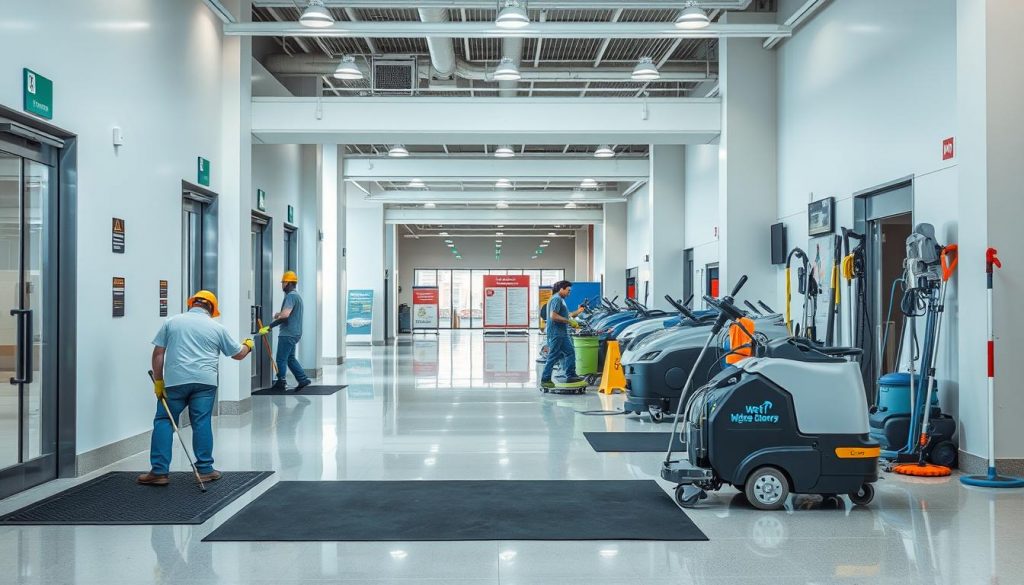
Choosing the Right Flooring Materials for Safety
When picking flooring for safety, the right choice is key. Many places choose non-slip flooring to prevent slips and falls. Textured vinyl is great for places like restrooms and kitchens because it’s easy to clean and has good grip.
Treated hardwood floors look nice but need extra care to stay safe. They’re best in entryways where looks and safety meet. It’s important to pick flooring that fits the area’s needs for safety.
Cleaning floors well is also vital for safety. Keeping floors clean helps them stay non-slip and looks good. Make sure cleaning methods don’t harm the floor’s texture or grip.
| Flooring Material | Non-Slip Capability | Best Usage Locations | Maintenance Requirements |
|---|---|---|---|
| Textured Vinyl | High | Kitchens, Restrooms | Regular cleaning, avoid wax buildup |
| Treated Hardwood | Moderate | Entryways, Reception Areas | Frequent polishing, use non-slip treatments |
| Commercial Tile | High | Lobbies, Hallways | Deep clean periodically, control moisture levels |
| Cork | High | Offices, Break Rooms | Regular sweeping, occasional sealing |
Choosing the right flooring is just the start. Keeping floors clean and well-maintained is also important. Thinking carefully about each option helps create a safe and welcoming space for everyone.
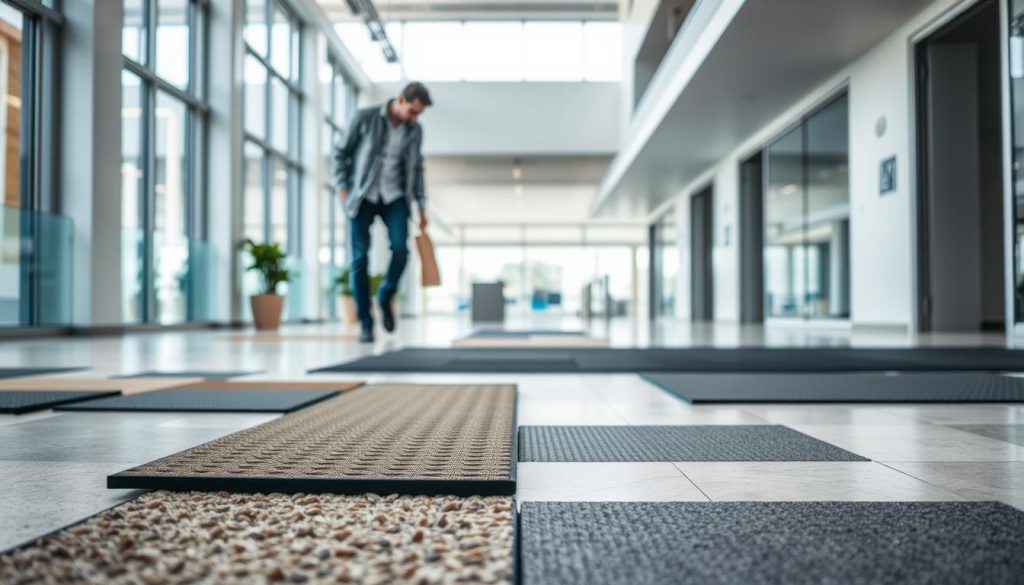
Daily Maintenance Practices for Floor Safety
Keeping floors safe in commercial spaces is key. Regular cleaning not only makes floors look good but also lowers slip and fall risks. It’s important for facility managers to create cleaning schedules that meet safety standards.
Structured cleaning routines include several steps:
- Regular sweeping and mopping to remove debris and spills.
- Using the right cleaning agents that follow safety rules.
- Ensuring floors are dry after cleaning.
Checking for hazards regularly is also vital. Supervisors should look for signs of wear and tear that could cause slips. Acting fast on these issues helps prevent accidents.
Keeping a record of inspections and cleanings is helpful. This log helps check the quality of maintenance and makes sure staff follows safety rules. By sticking to daily maintenance, businesses can make floors safer for everyone.
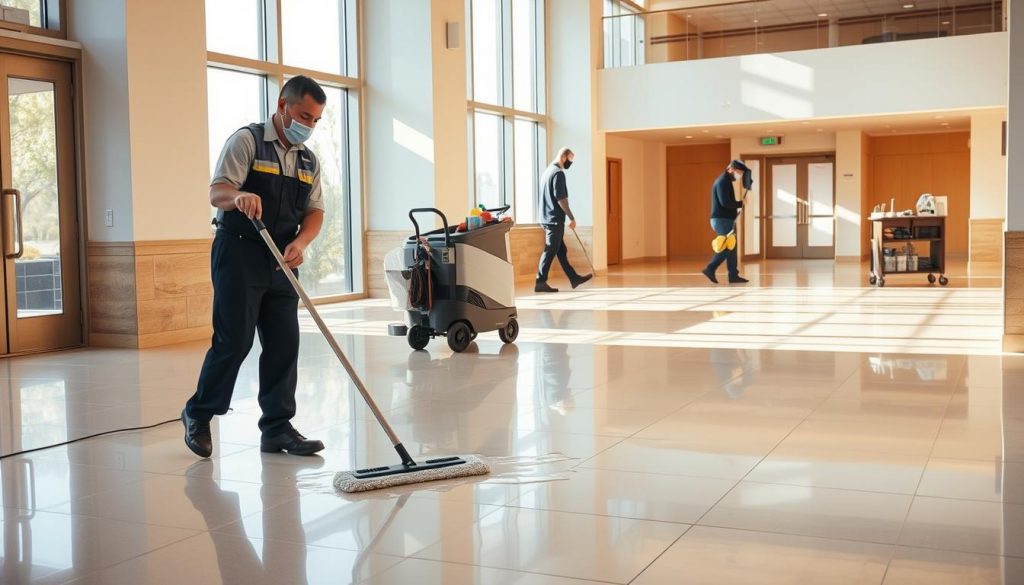
The Role of Anti-Slip Coatings and Treatments
In commercial settings, keeping floors safe is key. Anti-slip coatings play a big role in this. They make floors safer by improving grip, lowering the chance of slips and falls.
There are many anti-slip coatings out there, each for different floors. Epoxy coatings are strong and durable. Polyurethane coatings are flexible and great for busy areas. Choosing the right one depends on your facility’s needs.
Applying these coatings is easy but needs careful steps. First, prepare the floor, then mix the coating, and apply it right. Always follow the maker’s guide for best results. For big areas, getting help from pros ensures even coverage.
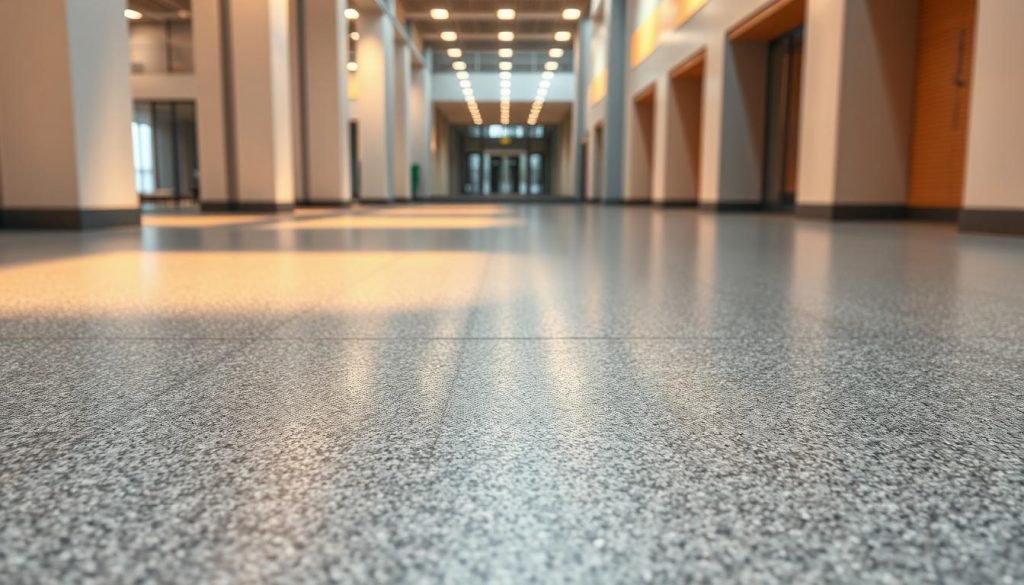
Anti-slip coatings do more than just make floors safer. They also make them last longer. These coatings protect the floor, saving you from expensive fixes or new floors. Working with trusted suppliers for top-notch products and advice is smart.
Wet Floor Safety Guidelines and Signage
It’s key to have wet floor safety rules in commercial places to cut down on slip-and-fall accidents. Clear signs warning of slippery floors help everyone move safely around wet spots. Good communication during cleaning times also helps avoid accidents.
Here are some tips for placing wet floor signs:
- Put signs where surfaces are wet.
- Use bright colors and clear icons to grab attention.
- Make sure to show exactly where the wet area is.
- If your place has people speaking different languages, use bilingual signs.
Training maintenance staff on wet floor safety is also important. They should know to put up signs right after cleaning or spills. This step helps keep everyone safe and can stop expensive injuries and legal troubles.
Getting a professional cleaning service can help keep floors safe too. Regular cleaning gets rid of debris and spills fast, reducing slip risks. For more info, check out this resource on how pros can improve wet floor safety.
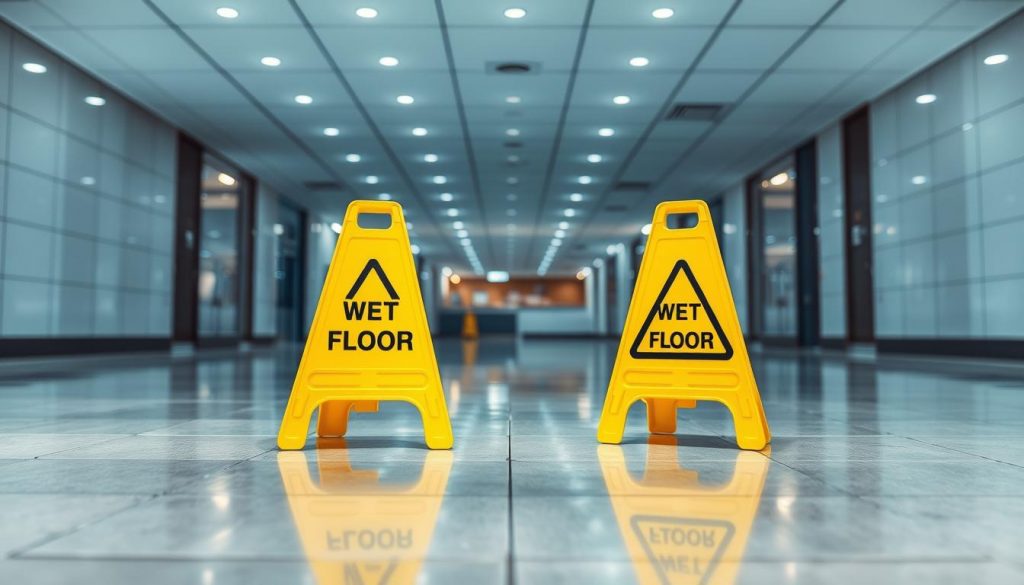
Commercial Floor Cleaning Safety Standards
Following commercial cleaning safety standards is key for safe commercial spaces. Groups like OSHA and ANSI have set rules for safe floor cleaning. These rules keep cleaning staff safe and protect facilities from dangers.
Using institutional cleaning protocols means training staff on safe chemical use and equipment handling. Regular training teaches staff about cleaning risks. This creates a safe work culture and lowers the chance of accidents.
The table below shows important parts of commercial cleaning safety rules:
| Protocol Component | Description | Importance |
|---|---|---|
| Equipment Safety | Regular check-ups and upkeep of cleaning tools. | Prevents accidents from broken equipment. |
| Chemical Handling | Safe labeling and storage of cleaning products. | Lessens the chance of chemical spills or misuse. |
| Floor Maintenance | Regular cleaning and checking of floor conditions. | Helps spot and fix slippery floor risks. |
Checking against commercial cleaning safety standards is vital for businesses. They should keep improving with staff training and following these rules. This keeps employees and visitors safe from slippery floors. For more on professional floor cleaning and following these standards, visit this resource.
Training Employees on Slippery Floors and Safety Protocols
Teaching employees about safety is key to avoiding slips and falls in work places. It’s important to make sure everyone knows how to stay safe. When staff is well-trained, they help keep the workplace safe for everyone.
What makes a good training program? It should cover:
- A thorough look at slippery floor dangers
- Practical lessons on how to handle emergencies
- Regular updates to keep knowledge fresh
- Space for talking about safety worries
Teaching how to respond in emergencies is a big part of training. Workers should know how to report dangers, give first aid, and call for help. This training makes them ready to act and helps build a safety-first culture.
Here’s how often training should happen and its effects on safety:
| Training Frequency | Reported Slip and Fall Incidents | Employee Confidence Level |
|---|---|---|
| Monthly | 5 | 85% |
| Quarterly | 10 | 70% |
| Annually | 15 | 50% |
Training often keeps everyone alert and responsible for safety. By focusing on safety training, workers become key players in a safe work environment. This effort greatly reduces accidents caused by slippery floors.
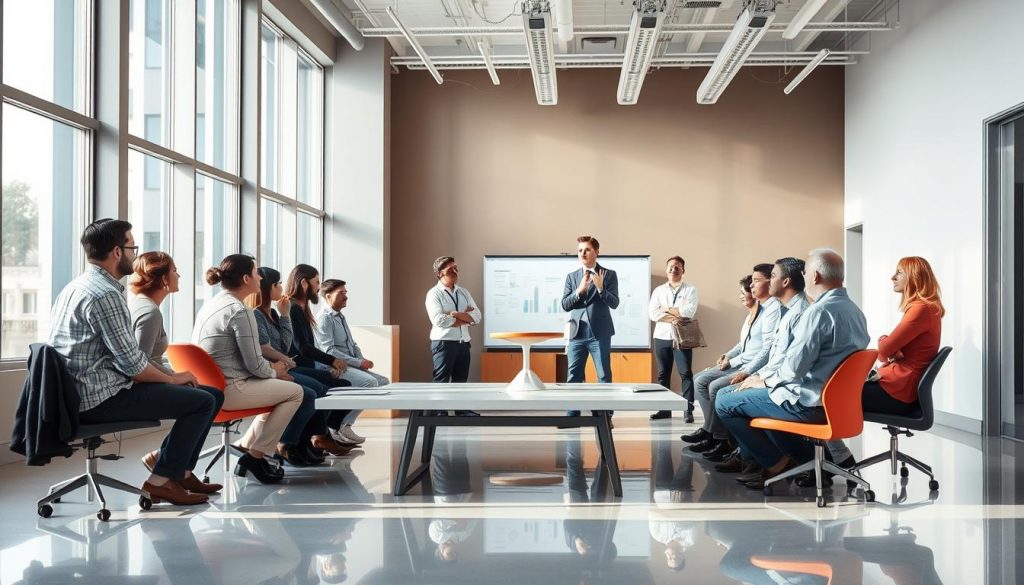
Utilizing Technology for Improved Floor Safety
Using technology to make floors safer is a big step forward. It helps businesses keep their spaces safe from slips and falls. Tools like slip detection sensors can spot trouble spots and alert staff, keeping floors safe when it matters most.
Smart cleaning robots are also changing how we clean. These robots can move around on their own, cleaning up spills and messes. Using them regularly keeps floors clean and safe.
Maintenance tracking tools help manage floor safety too. They keep records of cleaning schedules and how well the floors are kept. This information helps find and fix any safety issues, making sure technology is used wisely to keep everyone safe.
| Technology | Function | Benefits |
|---|---|---|
| Slip Detection Sensors | Detect and alert staff of slippery conditions | Reduces accidents and quickens response times |
| Smart Cleaning Robots | Autonomously clean and maintain floors | Ensures consistent cleanliness, lowering slip risks |
| Maintenance Tracking Solutions | Document cleaning and maintenance activities | Provides insights to improve safety protocols |
Seasonal Considerations: Managing Slips and Falls in Different Weather
Weather changes affect floor safety in commercial places. It’s important to know how different seasons impact floors. Rain, snow, and ice can cause accidents if not handled right.
When it rains, floors get slippery. This means we need to clean more and use mats at doors. Making sure people wear the right shoes for wet weather helps a lot.
In winter, snow and ice are big problems. Keeping outdoor areas clear of ice is key. Inside, using anti-slip treatments on floors can help.
Knowing how weather affects floor safety is critical. Training staff to spot slippery spots is important. Having plans for each season helps keep everyone safe.
Regular Risk Assessments and Safety Audits
It’s vital to do safety audits and risk assessments for floor safety in commercial spaces. These steps help spot slip and fall dangers before they cause big accidents.
Here’s how to do it right:
- Identify key areas: Look closely at busy spots like entrances, kitchens, and bathrooms.
- Analyze footwear: Check what shoes people wear to see if they’re safe on the floor.
- Inspect flooring surfaces: Look for any damage or wear that could be dangerous.
- Review cleaning protocols: Make sure cleaning doesn’t make floors slippery.
Regular checks can really cut down on accidents. Companies should set up a schedule for safety audits. This keeps everyone on the lookout for dangers and helps create a safer workplace.
| Audit Components | Importance | Frequency |
|---|---|---|
| Visual Inspections | Identify immediate hazards | Monthly |
| Risk Assessments | Evaluate possible risks | Quarterly |
| Employee Feedback | Learn about real dangers | Biannually |
| Floor Maintenance Review | Check if safety standards are met | Annually |
By doing regular risk assessments and safety audits, teams can tackle problems early. This careful monitoring helps make the workplace safer for everyone.
Best Practices for Restaurant Floor Hazards
Restaurants have to work hard to keep their floors safe. It’s important to always watch for hazards and follow the best practices. Keeping the floors dry is key to avoiding slips and falls.
Regularly cleaning the floors and quickly dealing with spills helps a lot. High-traffic areas need extra attention.
Putting non-slip mats in places like near sinks and cooking stations is a smart move. These mats help a lot when the floors are wet. It’s a must-have for any restaurant.
Teaching staff how to handle spills and clean properly is also important. They need to know how to spot hazards and act fast.
Using the latest cleaning methods and tools can make things safer. Getting professional cleaning services often helps meet health standards. They keep the kitchen clean and safe.
Choosing eco-friendly cleaning helps the planet and keeps everyone healthy. A clean and safe place is good for everyone. Listening to staff and making changes based on their feedback is key. For more tips, check out professional cleaning strategies for restaurants.
How to Prevent Slips and Falls at Work in Industrial Settings
Preventing slips in industrial settings needs a detailed plan. These places have special safety challenges, like different floor types. It’s key to keep floors clean and dry through regular maintenance.
Following strict safety rules is also vital. The National Floor Safety Institute sets guidelines for floors and upkeep. Companies should check their floors for slip risks and use anti-slip solutions if needed.
Training workers is another important step. They should know how to avoid slips, like using walkways and storing things right. Safety meetings help keep everyone focused on staying safe.
| Strategy | Description | Benefits |
|---|---|---|
| Effective Maintenance Protocols | Regular cleaning and inspections to eliminate hazards. | Reduces accidents, ensures compliance with safety regulations. |
| Adhering to Slip Prevention Standards | Implementing guidelines for floor materials and conditions. | Enhances safety, minimizes risk of liability. |
| Ongoing Employee Training | Training staff on slip awareness and safe practices. | Improves employee confidence, reduces incidents. |
Facility Floor Maintenance Tips for Long-Term Safety
Keeping floors in good shape is key for safety in work places. Regular care makes floors look better and stops slips. This is important for everyone’s safety.
Having a plan for floor care is a must. It helps floors last longer and keeps them safe. Here are some tips:
- Make a schedule for cleaning that covers daily, weekly, and monthly tasks.
- Use the right cleaning stuff for each floor type.
- Put on anti-slip stuff when needed to keep floors grippy.
- Teach staff the newest ways to care for floors.
Teaching staff is a big part of good floor care. They need to know how to take care of different floors. They also need to know the best cleaning products and methods.
By focusing on these safety tips, businesses can lower slip risks. This makes work places safer for everyone.
Conclusion
In this ultimate guide recap, we’ve covered many floor safety strategies. These are key to stopping slips and falls in commercial buildings. We’ve looked at why they happen and how to keep floors safe.
Preventing slippery floors is very important for safety. It keeps employees and customers safe. Businesses should work with experts like 360 Floor Cleaning Services for custom plans.
If you’re in Atlanta, Georgia, and want to make your place safer, call 404-991-8895. They offer free estimates and can check your space. Strong floor safety measures are a big step towards a safe and welcoming place for everyone.
FAQ
Why is preventing slippery floors important in commercial settings?
Keeping floors safe is key to avoid accidents. Accidents can hurt people and cost businesses a lot. Following OSHA rules and using safety steps makes places safer.
What are some common causes of slippery floors in facilities?
Spills, moisture, wrong flooring, and weather like rain or snow cause slippery floors. Knowing these helps managers keep places safe.
How can businesses implement effective floor safety strategies?
To stop slips and falls, improve drainage and use non-slip mats. Clean well and check floors often for dangers.
What flooring materials are best for preventing slips?
Textured vinyl, treated hardwood, and commercial tile are good for places like kitchens. They grip well and last long.
What daily maintenance practices contribute to floor safety?
Clean regularly, fix spills fast, and check floors often. This way, dangers are found and fixed quickly.
How do anti-slip coatings improve floor safety?
Anti-slip coatings make floors less slippery, which is great for busy or wet areas. Choose good products and apply them right.
Why is wet floor signage essential?
Wet floor signs warn people of dangers when floors are wet. They help prevent accidents by making everyone aware.
What are the established safety standards for commercial floor cleaning?
OSHA and ANSI have rules for cleaning floors. These rules focus on training staff and following guidelines to keep everyone safe.
How can I train employees on slip prevention protocols?
Teach a safety-first culture and emergency plans. Make sure staff knows how to prevent slips and falls.
What role does technology play in enhanced floor safety?
Tech like sensors and cleaning robots helps keep floors safe. They make cleaning better and find risks early.
How does seasonal weather affect floor safety?
Weather like ice or rain makes floors slippery. Businesses need to clean more and use special safety steps in bad weather.
Why are regular risk assessments important?
Regular checks find and fix slip dangers. This keeps places safe and lowers risks for businesses.
What best practices should restaurants follow for floor safety?
Keep floors dry, use non-slip mats, and train staff on spills. These steps help avoid accidents in kitchens.
What specific strategies can be applied in industrial settings to prevent slips?
Industrial places need strict cleaning and follow safety rules. Train staff well to handle safety issues with floors.
What long-term maintenance strategies ensure ongoing floor safety?
Use regular maintenance plans and train staff on new cleaning methods. This keeps floors safe for a long time.
